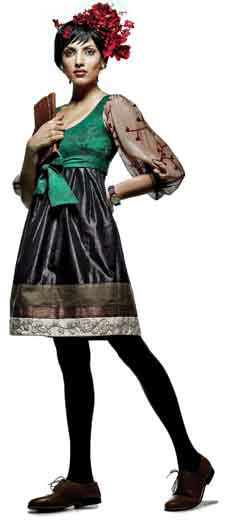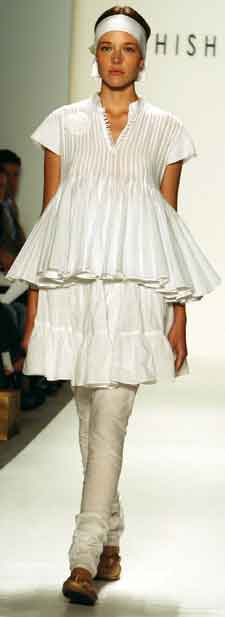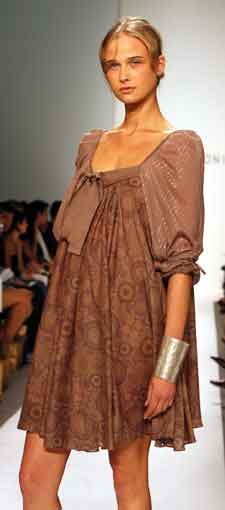Life
Indian Designers on Project Runway

Indian designers edge into the tent.
Indian fashion designers are finally edging into the famed white tents of Bryant Park in New York. While Indian influences have long permeated American fashion and many clothes American consumers wear are made in India or by Indian American garment companies here, we are now actually beginning to see designers from India becoming visible in international markets.
The hedonistic hordes that lined the white tents at the Olympus Fashion Week in Bryant Park in New York in September were focused on the up or down of a hemline, the new silhouettes or the return of the jacket. Buyers, fashion editors, celebrities, socialites and photographers had all gathered to view the latest diktats of the fashion czars. As cameras flashed and the crowds pushed, careers were made and unmade. Now it seems that this bastion of American fashion has opened up to designers from India. Along with major American and Parisian names, there were Ashish Soni and Sabyasachi Mukherjee, hotshot designers from India. Last year, Soni became the first Indian designer invited to participate at the Fashion Week, the most prestigious fashion show in the country and one of New York’s marquee events. Soni’s collection this year was inspired, according to his press notes, “by the vitality of Vienna of the early 1920’s when artists evolved the dynamic new language of Modernism. It expresses the simplicity combined with the rigorous composition and autonomy of the forms and colors of these artists.” Soni’s line was young and vibrant – all cottons and voiles – fun and breezy and just right for spring. The background musical score as the sullen models walked the ramp was of splashing waves and the cooing of birds. Interestingly, churidars, the traditional tight pants of ethnic wear from the Mughal days and part of contemporary India, had been brought full swing into the American fashion lexicon – worn under shorts, under tunics and short skirts. Indeed, there was nothing particularly Indian about the clothes except for a touch of embroidery here and there. Asked about the process of getting from Mumbai to the white tents, Soni explained that it was about invitations – and hard cash. Last year Indian tourism’s Incredible India campaign partnered with him and this season he and two partners who showcased their jewelry and accessories with him to split the costs. In 2005, Soni had been selected with nine other international designers as an emerging designer by UPS, which had defrayed the costs of the event.
Showing up under these famous tents can be expensive, in excess of $100,000 just to participate. “And it’s not just money, even if you have money that’s not enough to get a foot in. You have to be selected,” he says. “There are too many people waiting with checks in line to get those spots; that you get it is a bigger deal than anything else.” Soni says he’s had strong media response, the collection is selling and he is represented here by Showroom Seven, which is well known to buyers and represents several designers. Was his collection in New York the same as the one he markets in India? He says, “It was not what I showed hundred percent in India. I’ve showed bits and pieces of it in India, but it was completely geared up to the international market.” So has it become a global market and does he find himself hopping between international cities? “Absolutely. From here we go straight to London for the Fashion Week. Initially it used to be just one or two of us, but now there’s almost five designers who are going to be showing in London.” Manish Arora has been in London for three seasons, as has Soni. Anamika Khanna is showing for the second time and Sabyasachi Mukherjee for the first time. Is the London market different from the U.S. market and is it more receptive? Says Soni, “Totally. They are a little bit more receptive, the price points are lower and volumes are of course lower, but in that sense easier to crack.” He points out that mostly mainstream fashion aficianados attend Fashion Week, and he is also selling at stores like Selfridges. Does he think Indian designers will have more of an impact during future Fashion Weeks in New York? “Well, it’s been just me and now Sabya. Hopefully if there are couple more of us, we could take a tent, but it will take us longer here than it has in Europe, because the markets here are much tougher.”
Indian fashion is usually about color, style, glitter, the whole nine yards, almost like an Indian wedding. Does he think the designers have to reinterpret their designs for different markets? He says, “Absolutely, it works very differently.” Indeed, you can’t give them the whole of India at one go. A lot of designers do that, but Soni says, “I’m trying harder and harder every season to position it in a way that we are a global brand and we sell the same things across the world. That is the strategy going forward.” As he points out, the market is changing even in India with younger people dressing similar to their counterparts in the West: “That’s the reason why we are not saying we are customizing things for India, because Indians are as modern as anyone else, if not more.” In his collection the churidar seems to have made a big comeback and seems to have merged into the western fashion vocabulary. In fact, he says that last season the churidar did very well and his company sold over a thousand pieces of churidars in Europe and Japan. Gone are the drawstrings and Soni’s churidars are completely contemporized. A designer who made his debut in the UPS tent as an emerging designer this year is Sabyasachi Mukherjee, who is well known in India. This Calcutta designer won the 2007 Indian National Award in Costume Design (the equivalent of an Indian Oscar) for his work in the movie Black. You can always expect the unexpected from Sabyasachi – his first collection was inspired by the sex workers of Sonagachi, the red light district of Calcutta. Sabyasachi’s edgy clothes use traditional Indian techniques, such as tea stained fabrics with a very contemporary touch He started out with the Lakme Fashion Week.
Sabyasachi’s Spring/Summer 2007 Collection used a combination of unusual processes to obtain subtle texturing, and laborious means of mud and discharge printing. The collection was certainly different enough to get a lot of attention and was featured twice in the New York Times. Tom Julian, director of trends for McCann-Erickson, was quoted by AP as saying: “This Indian designer has shown us the hand-woven look with rich fabrics and modern embellishments, but more importantly, has taken Western silhouettes – the blouson, the cowl back and the A-line – and is making a strong signature for a young designer.” So, have the buyers been biting? He says it usually takes a while after the show for that to kick in, but surprisingly several buyers from abroad have already placed orders worth about $50,000 in the first few days after the shows. “I think the collection had a very strong international edge and at the same time it had an Indian appeal to it. I think that’s what the buyers are looking for in any case. Right now the world is looking for different things so the receptivity for these kinds of things is quite high. Does it have anything to do with India’s changed image in the world? “Yes, that’s definitely the case, so I think I’m at the right place at the right time. The entire perception of India in the west has completely changed.” Sabyasachi, who is represented by a company called People’s Revolution, intends to sell to stores in the United States, but does not plan to have his own store here. He has shown in Milan, New York and London Fashion Weeks. He laughs, “Once I do the Paris Fashion Week, I’ve kind of done the Grand Slam.” While the Indian market calls for a different sensibility, does he bring in Indian touches into his collection which show internationally? He says: “Absolutely. I think it’s very important to have an Indian soul and I try to incorporate that by using Indian fabrics and prints. But it’s if is designed well, it could be made in India, but it could have been made by any designer across the globe.” So he’s not bringing any overly Indian touches like churidars into it? “No, no, I have churidars in this collection – but in the sleeves! I have women’s fitted shirts with roucered sleeves, like churidars. So there is an Indian update to the clothes, a slight Indian touch to it, but it is subtle. It’s not easily perceivable as Indian.”
Sabyasachi told the New York Times: “I thought the best way was to start by doing something Indian. It is no longer perceived as exotic. I see the whole global market like a spice rack. If the pepper is missing, you’ve got to give them pepper.” |





